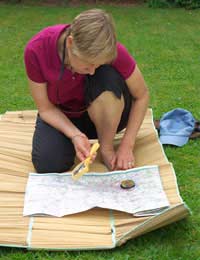Navigating With Compass And Map

Although technological advances and the use of GPS navigational systems have started to become the norm for outdoor adventurers, when you want to determine how to get from point A to point B, knowing how to find direction using a map and a compass is still a vital skill to learn for back up. However, in a survival situation, even if you have a map and compass with you, it’s often recommended that you stay put and wait for rescue to arrive as opposed to trying to reach safety yourself unless you’re absolutely sure what you’re attempting is achievable.
There are no hard and fast rules about what you should do in this regard. It’s likely to depend on a number of factors such as the weather, the terrain in which you are stranded, your navigational skills, the distance you are from safety, your food and water supplies and any injuries you or your party might be carrying, but knowing how to read a map and compass is a skill that might just come in handy.
In the UK, Ordnance Survey maps are your best bet. These not only show you the directions to and from places but also allow you to gauge distance and they show you the topography and features of the terrain as well as useful landmarks.
Using a Map and Compass
To enable you to navigate using a map, you also need a compass which has four cardinal points – north, south, east and west. However, something to bear in mind is that a compass never really points to ‘true’ north, except by coincidence in some locations, but its needle is attracted by ‘magnetic’ north which constantly fluctuates and varies in different places on the earth. So, when you’re reading north on a compass, what you’re really establishing is the direction of the magnetic north pole.To take a compass bearing from a map you should draw a straight line on your map which passes through both your location point and your destination point and extend the line across any of the map borders. Then, you need to centre the compass where the line you’ve drawn intersects the map border and align the axis of the compass north-south or east-west with the border line. Then you can read the true bearing of the line you’ve drawn.
Some compasses are marked with the number of degrees in a circle, which makes sense given that the earth is a sphere so, remember that north = 0 degrees, east = 90, south = 180 and west = 270. Then, from where you are standing, set your compass so that north or ‘zero degrees’ aligns with your magnetic north needle, then take the magnetic bearing and start to follow this direction to reach your destination.
Using Magnetic Declination Maps
As stated however, true north and magnetic north are not the same, unless you have a compass that has a built-in magnetic declination adjustment. If you need more accuracy, you’ll have to consult a magnetic declination map for the geographic area you’re in to make the calculation adjustments you’ll need to make an accurate reading.Factors to Watch Out For With Compasses
Because we’re talking about magnetic fields here, it’s important to remember that compasses can be affected by iron and steel objects so when you need to take an accurate reading, make sure the compass is not placed near pocket knives, belt buckles, railway tracks, overhead power lines etc.However, all things aside, whilst a map and compass can help get you out from a survival situation safely, if you encounter a very dangerous and difficult survival scenario, your best bet would be to stay where you are, signal for help and wait to be rescued.


Re: How to Get Out Of A Mud Bog (Quicksand)
I was 8 years old, my family went to visit our neighbors where we previously lived in Tool,Texas. The family had…
Re: How to Get Out Of A Mud Bog (Quicksand)
I was sinking in a mud bog yesterday for 3 hours until I was pulled out. How do I cope now?
Re: Dangers and Benefits of Leeches
Can it penetrate completely into the body through navel ? If, then how one can know that it has entered into body ? And what…
Re: How To Survive A Forest Fire
I like cheese.... ????????????????????????????
Re: Dangers and Benefits of Leeches
The easiest way to remove a leech from skin is just by sprinkling salt over the leech which would immediately detaches itself…
Re: Dangers and Benefits of Leeches
I'm 14 and was swimming st Brady's run in beaver county and I got bit by a leech.. I would of never knew unles my boyfriend…
Re: What Are Survival Seeds?
The other evening, I found all my matches were damp and I had to ignite my wood burning stove using a rolled up piece of paper and my…
Re: Where Can I Try Out my Survival Skills?
i been doing some survival practise is my back garden but i could use some new bet cheap and relieable gear. thank you
Re: Surviving in the Desert
Hi I am in the process of doing research for a novel. The main characters are trapped in a desert and there is an on coming sandstorm.…
Re: How to Start a Fire
So lets just say, I am aware this sounds crazy but hear me out, what if there was a zombie apoccolypse (Have no frickin idea how to spell…